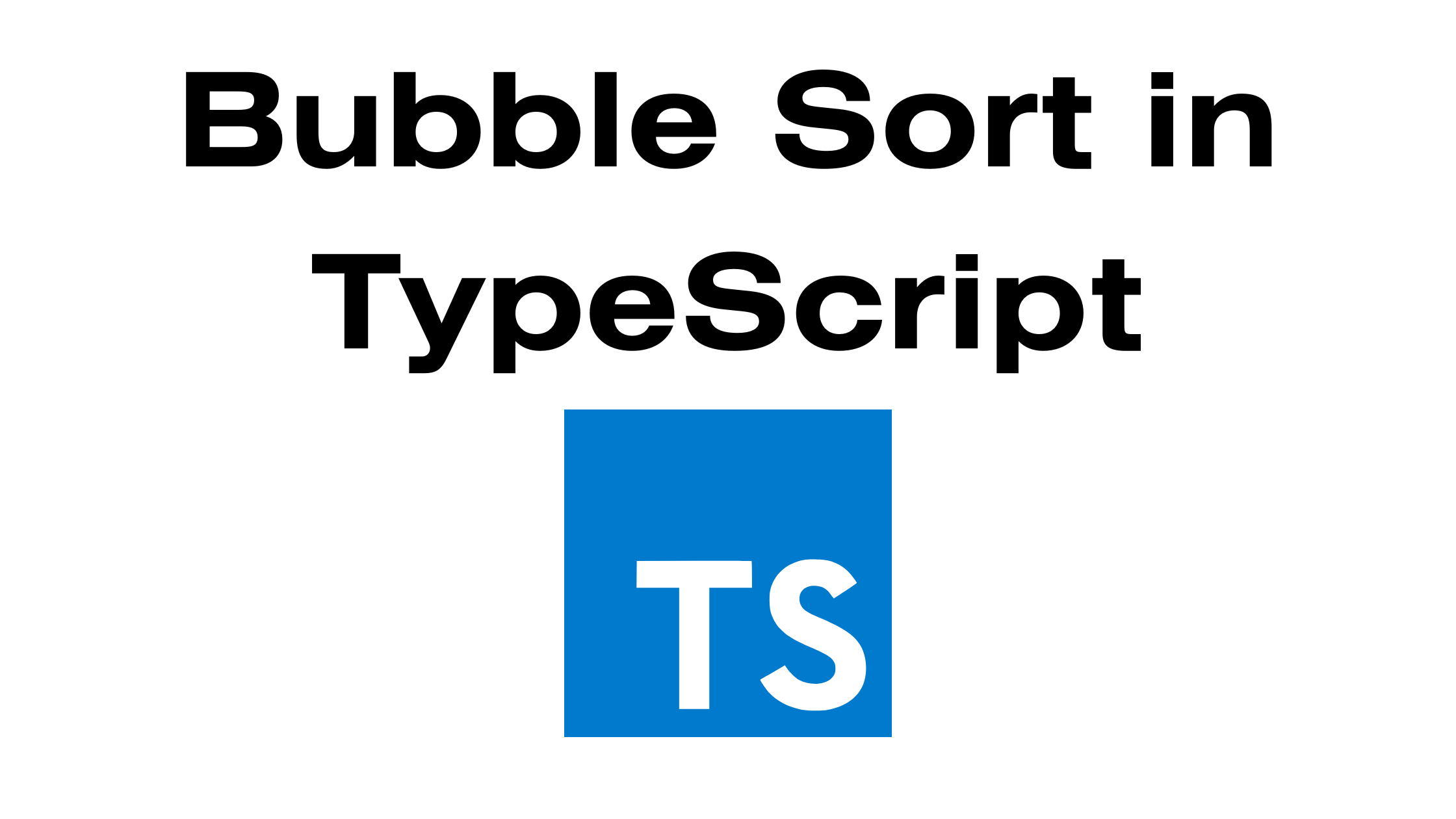Understanding the Bubble Sort Algorithm in TypeScript: A Step-by-Step Guide
Introduction:
Sorting algorithms play a crucial role in computer science and software development. Among these algorithms, Bubble Sort is one of the simplest and easiest to understand. In this blog post, we’ll explore the Bubble Sort algorithm in depth and implement it in TypeScript. We’ll walk you through the algorithm’s key concepts, step-by-step implementation, and provide insights into its time complexity. By the end of this article, you’ll have a solid understanding of how Bubble Sort works and be able to implement it confidently in your TypeScript projects.

Table of Contents
- What is Bubble Sort?
- Introduction to Bubble Sort.
- How Bubble Sort works.
- Step-by-Step Implementation in TypeScript
- Setting up your TypeScript environment.
- TypeScript basics: variables, loops, and functions.
- Bubble Sort implementation in TypeScript.
- Understanding Time Complexity
- Best-case, average-case, and worst-case scenarios.
- Big O notation and Bubble Sort’s time complexity analysis.
- Optimizing Bubble Sort
- Discussion on the inefficiency of Bubble Sort.
- Practical applications and limitations.
- Alternative sorting algorithms to consider.
- Conclusion
- Recap of Bubble Sort’s key concepts.
- When to use Bubble Sort.
- Resources for further learning.
What is Bubble Sort?
Bubble Sort is a simple comparison-based sorting algorithm. It gets its name from the way smaller elements “bubble” to the top of the array during each pass. Here’s how it works:
- Start at the beginning of the array.
- Compare the first two elements.
- If the first element is larger than the second, swap them.
- Move to the next pair of elements and repeat steps 2 and 3 until you reach the end of the array.
- After the first pass, the largest element has “bubbled up” to the end of the array.
- Repeat the process for the remaining unsorted elements (excluding the last one).
- Continue this process until no more swaps are needed.
Step-by-Step Implementation in TypeScript
Setting up your TypeScript environment
Before diving into the implementation, make sure you have Node.js and TypeScript installed on your system. If not, you can download them from the official websites.
TypeScript Basics
To implement Bubble Sort in TypeScript, you need a good grasp of TypeScript fundamentals like variables, loops, and functions. If you’re new to TypeScript, consider going through the TypeScript documentation or tutorials.
Bubble Sort Implementation in TypeScript
Here’s a TypeScript function that implements the Bubble Sort algorithm:
function bubbleSort(arr: number[]): number[] {
const n = arr.length;
let swapped: boolean;
do {
swapped = false;
for (let i = 0; i < n - 1; i++) {
if (arr[i] > arr[i + 1]) {
// Swap arr[i] and arr[i + 1]
[arr[i], arr[i + 1]] = [arr[i + 1], arr[i]];
swapped = true;
}
}
} while (swapped);
return arr;
}
// Example usage:
const unsortedArray = [64, 34, 25, 12, 22, 11, 90];
const sortedArray = bubbleSort(unsortedArray);
console.log(sortedArray); // Output: [11, 12, 22, 25, 34, 64, 90]This TypeScript function, bubbleSort, takes an array of numbers as input and sorts it in ascending order using the Bubble Sort algorithm. The do...while loop continues until no more swaps are needed, indicating that the array is fully sorted.
Understanding Time Complexity
Best-case, Average-case, and Worst-case Scenarios
Bubble Sort’s time complexity varies depending on the initial order of the elements. In the best-case scenario, where the array is already sorted, Bubble Sort has a time complexity of O(n). However, in the average and worst-case scenarios, its time complexity is O(n^2), making it less efficient compared to other sorting algorithms for large datasets.
Big O Notation and Bubble Sort’s Time Complexity Analysis
The time complexity of Bubble Sort can be analyzed using Big O notation. For an array of size n, Bubble Sort performs n passes, with each pass having a worst-case time complexity of O(n). Therefore, the overall worst-case time complexity is O(n^2).
In practice, Bubble Sort is not recommended for large datasets due to its inefficiency. However, it remains a useful algorithm for educational purposes and for sorting small datasets where its simplicity outweighs its performance drawbacks.
Optimizing Bubble Sort
Discussion on the Inefficiency of Bubble Sort
Bubble Sort’s primary drawback is its poor time complexity, especially when dealing with large datasets. It performs a large number of unnecessary comparisons and swaps, even when the array is nearly sorted.
Practical Applications and Limitations
While Bubble Sort may not be suitable for large-scale applications, it can be valuable in situations where simplicity and ease of implementation are more critical than performance. It can also serve as a starting point for understanding sorting algorithms before exploring more efficient options.
Alternative Sorting Algorithms to Consider
If you’re working on projects that require efficient sorting, it’s advisable to explore alternative sorting algorithms like Quick Sort, Merge Sort, or the built-in Array.prototype.sort() method in JavaScript, which uses an optimized sorting algorithm.
Conclusion
In this comprehensive guide, we’ve explored the Bubble Sort algorithm in TypeScript. We’ve covered its step-by-step implementation, time complexity analysis, and discussed its limitations and alternatives. While Bubble Sort is not the most efficient sorting algorithm for large datasets, it offers valuable insights into sorting techniques and can be a great starting point for those new to sorting algorithms. Understanding sorting algorithms is essential for any programmer, and Bubble Sort is a fundamental concept to grasp.
Now that you have a solid understanding of Bubble Sort, consider exploring more advanced sorting algorithms and applying them to real-world programming challenges. Sorting algorithms are a crucial part of computer science and are widely used in various applications, from data processing to web development.



